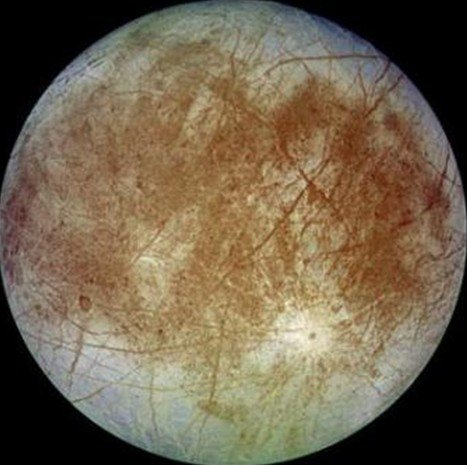(单词翻译:单击)
听力文本
This is Scientific American — 60-Second Science. I’m Steve Mirsky.
"And this mission would be NASA’s first mission that is directly tasked with searching for signs of life on another world since the Viking Spacecraft were given that task back in the 1970s on the surface of Mars."
Kevin Hand of NASA’s Jet Propulsion Laboratory.
"We talk about finding, searching for signs of life on some of these ocean worlds, and in particular these geologically active ocean worlds with rocky seafloors like Europa."
Hand spoke February 17th at the annual meeting of the American Association for the Advancement of Science in Boston. He’s the deputy project scientist for the Europa mission, which plans to send a lander to the ice-covered moon of Jupiter.
"We’re talking about environments where life could be alive today...so these ice shells may serve as a window into the oceans below and oceanic material may be coming up to the surface. Where a mission like a lander could actually sample that material directly...and I’m the pre-project scientist for this mission. This is a mission that would reach the launch pad in the 2024–2025 time frame, it would land on Europa’s surface and operate for about 20-plus days."

The instrumentation that gets sent to Europa needs to be recognize signs of life in minute amounts.
"A picomole of organics per gram of sample is one key requirement. Being able to detect cell number abundances to as low of a level as 100 cells per milliliter of ice acquired from Europa’s surface. We reached that benchmark by comparison to subglacial Lake Vostok here on Earth. And the size that the microscope in the model payload would need to be able characterize is down to a 0.2 micron diameter for any putative organisms collected in a surface sample of Europa. This mission is a bold, very exciting mission that marks NASA’s return to the direct search for life via in situ capabilities on a potentially inhabited ocean world beyond Earth."
Thanks for listening for Scientific American — 60-Second Science Science. I’m Steve Mirsky.
参考译文
这里是科学美国人——60秒科学。我是史蒂夫·米尔斯基。
“继上世纪70年代海盗号宇宙飞船在火星表面执行探测任务后,这项任务将是美国宇航局首次直接负责在另一个世界探寻生命迹象。”
凯文·汉德来自美国国家航空航天局的喷气推进实验室。
“我们谈论的是在某些海洋世界发现和寻找生命迹象,特别是在地质活跃、有岩石海床的海洋世界,比如木卫二。”
汉德在2月17日于波斯顿举行的美国科学促进会年度会议上发表了讲话。汉德是木卫二任务的副项目科学家,该任务计划向被冰雪覆盖的木星卫星上发射着陆器。
“我们正在讨论的是现在生命可以生存的环境,这些冰层就像透视海底的窗口,而海洋物质也可通过冰层浮到表面。这样着陆器就可以直接在表面为海洋物质取样,我是这项任务的前期科学家。这一着陆器预计在2024年至2025年到达发射台,登陆木卫二表面后运行20余天。”
发射到木卫二的仪器要识别出微小的生命迹象。
“其中一项关键要求是,每克样本中有1皮摩尔有机物。能从木卫二表面获得的低至每立方米100个的细胞中检测出细胞数量的丰富程度。我们通过将木卫二与地球上冰川下的沃斯托克湖对比进行对比,得到了这一基准。为了观察在木卫二表面收集的任何假定的微生物,模型有效载荷的显微镜直径要降至0.2微米。这是一项大胆且令人非常兴奋的任务,这标志着在地球之外可能有生命的海洋世界中,美国国家航空航天局开始重新利用原位技术直接寻找生命。”
谢谢大家收听科学美国人——60秒科学。我是史蒂夫·米尔斯基。
译文为可可英语翻译,未经授权请勿转载!
重点讲解
重点讲解:
1. be tasked with 给…分配任务;派给…(工作);
例句:The minister was tasked with checking that British aid money was being spent wisely.
部长被指派去督查英国的援助资金是否已用到实处。
2. search for 搜寻;搜索;搜查;寻求;
例句:He searched for work at various stores.
他在各家商店寻找工作。
3. in particular 尤其;特别;
例句:In particular, overseas sales increased by about 10 percent.
特别是海外销售大约增长了10%。
4. be able to do sth. 能做到…的;
例句:Having found the cause, I was able to propose a remedy.
找出了原因,我就能提出解决办法了。


